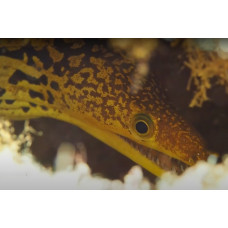Latin name
Enchelycore anatina
Other name
Tiger moray or bird-eye conger.
Identification
The Fangtooth moray has an elongated, powerful body that is slightly compressed from the sides. Its head has a slightly raised occipital region. Its jaws are elongated and contain a large number of long, glass-like teeth. It has 146–158 vertebrae.
Features of fish fins
The dorsal and anal fins are fused with the caudal fin, all of which are covered with thick skin. The dorsal fin begins above or slightly in front of the gill openings on the head. There are no pectoral or pelvic fins.
Fish colouring
The fangtooth moray's body is moderate to dark brown, lighter on the front and lower part of the head. Small pale spots are scattered across its head, and large spots and patches are found on its body and fins.
Distribution
They are widespread in the warm waters of the Atlantic Ocean. Eastern Atlantic: The Canary Islands, the Azores, Cape Verde, Madeira, Saint Helena, and the eastern Mediterranean Sea. In the western Atlantic, they are found from Bermuda and Florida to Rio de Janeiro.
Habitat
This is a subtropical, marine, demersal species. They inhabit rocky bottoms that are rich in crevices. Depth range: 3 to 60 meters.
Size
These fish have a maximum body length of 120 cm.
Behavior
Moray eels are nocturnal carnivores.
Food and feeding habits
They hide among rocks, waiting for prey. Their diet consists mainly of bottom-dwelling fish, cephalopods, and crustaceans.
Reproduction
Fangtooth moray eels reproduce through external fertilization. Females release eggs, and males release sperm into the water column at the same time.
Fishing
It may be consumed in subsistence fisheries.
Relationship with a person
Harmless.
| Classification | |
| Phylum | Chordata |
| Class | Actinopterygii |
| Squad | Anguilliformes |
| Family | Muraenidae |
| Genus | Enchelycore |
| Species | E. anatina |
| Features | |
| Conservation status | Least Concern |
| Habitat | Bottom |
| Life span, years | No information |
| Maximum body weight, kg | No information |
| Maximum length, cm | 120 |
| Sailing speed, m/s | No information |
| Threat to people | Not edible |
| Way of eating | Predator |
Fangtooth moray
Tags: fangtooth moray



